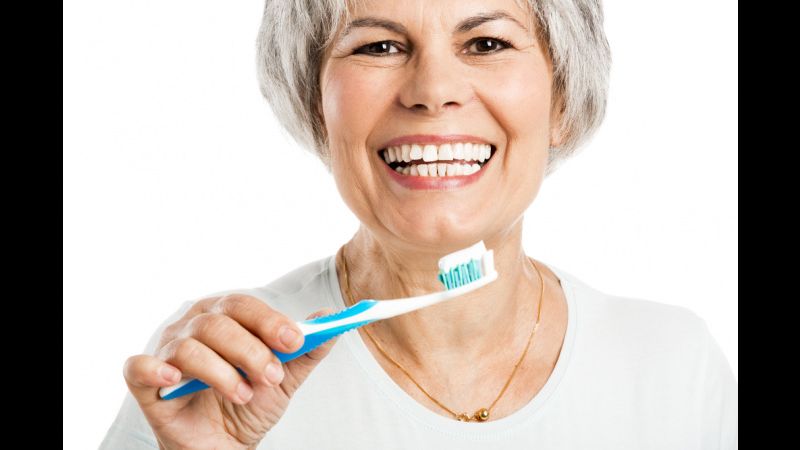By Guest Blogger Robin Amylon
30% of older adults aged 65 and over have no natural teeth. Changes in oral health are most likely the result of disease, medical treatment, medications or poor tooth hygiene rather than aging itself. The inability to bite and chew makes it difficult to consume certain foods. Increased tooth loss leads to inadequate intake of dietary fiber, vitamins and minerals.
Dentures, unfortunately, don’t fully solve this problem. Full dentures are not a perfect substitute for natural teeth. Both before and after denture placement, older adults may experience difficulty biting and chewing. Fresh whole fruits and vegetables, hard crusted breads and tough meats are the foods found to cause the most difficulty for those with complete dentures. With a few alterations in food consistency it is possible, however, to consume a healthy, balanced diet without a full set of teeth.
Remain well-nourished and consume foods from all food groups
Grains/Starches:
- Soak bread, crackers, or cold cereal in milk until it is soft enough to chew.
- Consume mashed potatoes
- Consume soft foods like macaroni and cheese, lasagna, ravioli or spaghetti
- Choose hot cereal like oatmeal, farina or grits
- Consume soups with soaked crackers
Vegetables:
- Cook vegetables until soft
- Mash or puree vegetables
Fruit:
- Use canned fruit in its own juices (peaches, pears, fruit cocktail)
- Choose soft fruits such as bananas, kiwi, oranges, or applesauce
- Puree fruits and make fruit smoothies with milk or yogurt
Meat/Protein:
- Eat meat with gravy or sauce. This will help to moisten the meat and make it easier to chew.
- Cut meat into very small pieces. If small pieces are still difficult to chew, then puree meats. Put the meat into a blender or food processor and grind to desired texture.
- Scramble eggs
- Consume soft boiled or baked fish
- Consume softer vegetarian sources of protein such as beans, tofu, cottage cheese and greek yogurt
Food is enjoyed with all the senses (sight, smell, taste, texture). Pureed meals need to look, smell and taste good. A good plate presentation and good tasting food will encourage adequate consumption and ultimately good nutrition. Stimulate appetite by preparing favorite foods and foods with pleasant smells. Including a variety of flavors and colors can also make a meal more appealing. Be creative when preparing and serving meals to improve acceptance. Here are some tips on how to make pureed dishes more tempting:
- Aroma. Good-smelling food and a pleasant atmosphere can increase appetite and improve consumption. Serve foods seasoned with aromatic ingredients such as garlic, pepper, onion and cinnamon
- Seasoning. Older adults tend to have a dulled sense of taste. Taste all foods and adjust seasoning as needed. Serve foods that have stronger flavors such as chili.
- Layering/swirling. Swirling vegetables together is simple and makes a great plate presentation. Make attractive layered casseroles such as shepherd’s pie, lasagna or chicken a la king
- Shapes. Shape pureed and ground foods to resemble their traditional dishes. Use commercial thickeners and food molds to form pureed meats into different shapes. Shape pureed fish into the shape of a fish. Flatten a spoonful of pureed meat to make a meat patty. Use small scoops to make meat resemble meatballs.
- Presentation. A typical dinner of baked chicken, potatoes, carrots and green beans can look like mounds of different colored mush. Use attractive plates and silverware to improve the visual appeal of a meal. Consider colors and shapes when arranging foods on a plate. Substitute brightly colored vegetables for white vegetables (replace mashed potatoes with mashed sweet potatoes). Colorful garnishes can also add eye appeal.
Consume a healthy diet to take good care of dentures
- Avoid foods that are sticky such as chewing gum, caramel, taffy
- Eat soft foods and cut food into small pieces when you are adjusting to your new dentures
- If you can only tolerate liquids at first add a liquid supplement to your diet such as Boost, Ensure, Glucerna (if you have Diabetes), or Carnation Instant Breakfast for added calories and protein. They will also help promote tissue healing
- Chew on both sides of your mouth to keep the pressure even
- Rinse your mouth often to help remove food debris
Keep your mouth clean and healthy
- Brush your remaining teeth, gums, tongue and roof of the mouth with fluoride toothpaste after each meal.
- Dentures should be cleaned with a soft-bristled toothbrush or denture cleaning brush, using a denture powder or paste, hand soap or baking soda. Do NOT use very hot water because it will cause the dentures to lose their original shape
- If you notice your dentures are fitting poorly, make an appointment with your dentist.
- Follow a healthful diet
Dentures should be checked periodically by a dental professional for appropriate fit. Changes in body weight or bone structure over time may alter the fit of dentures.
Robin Amylon is an NYC-based Nutritionist. She received her Bachelor of Science from Queens College in Nutrition and Exercise Science and is currently finishing a program at New York-Presbyterian Hospital to become a Dietitian.

